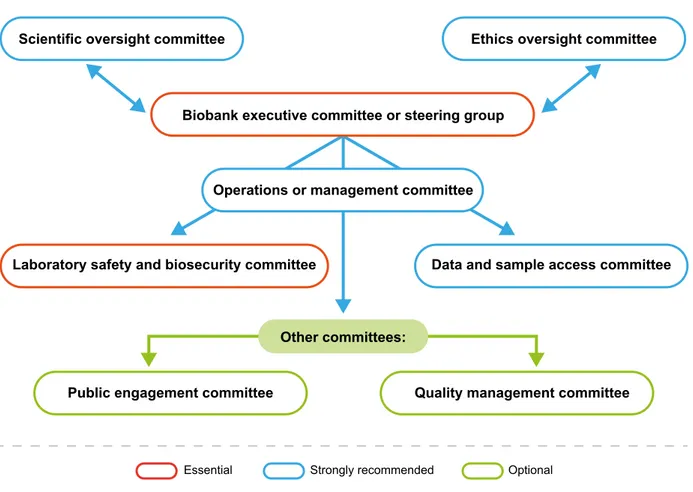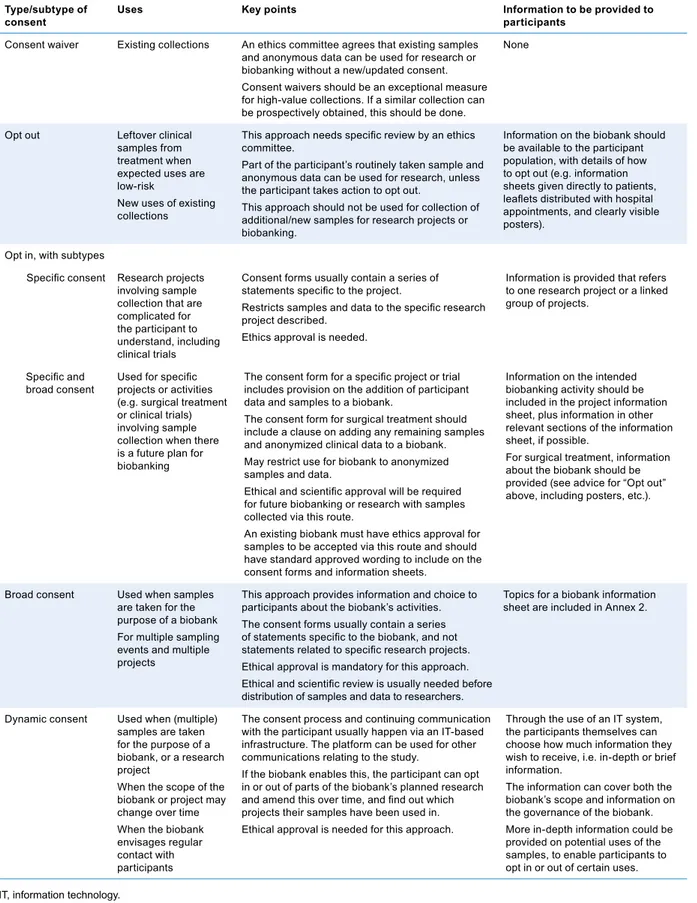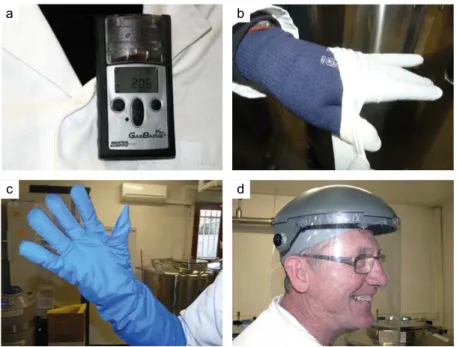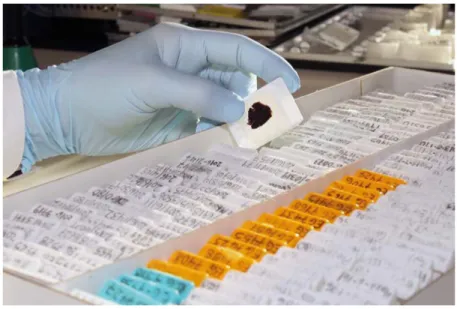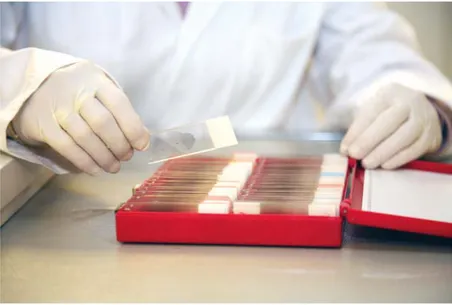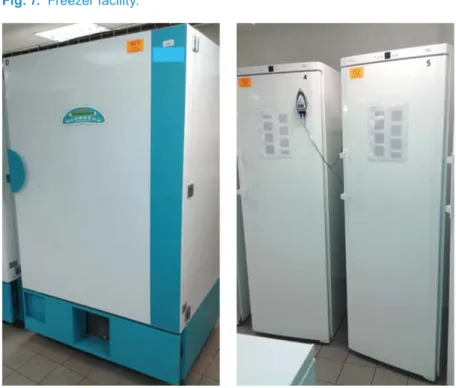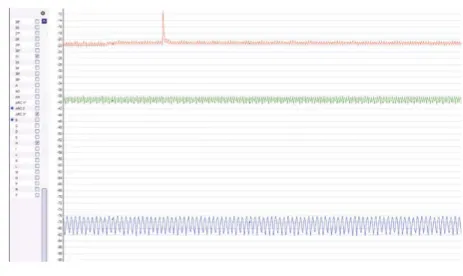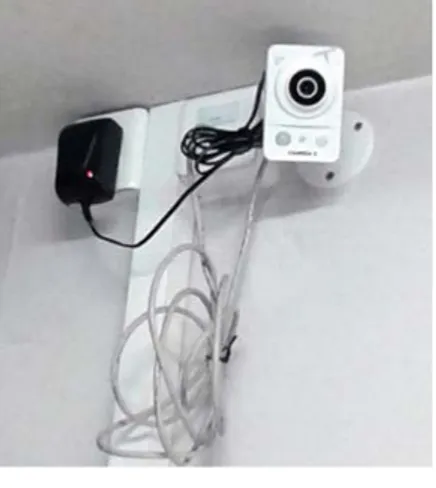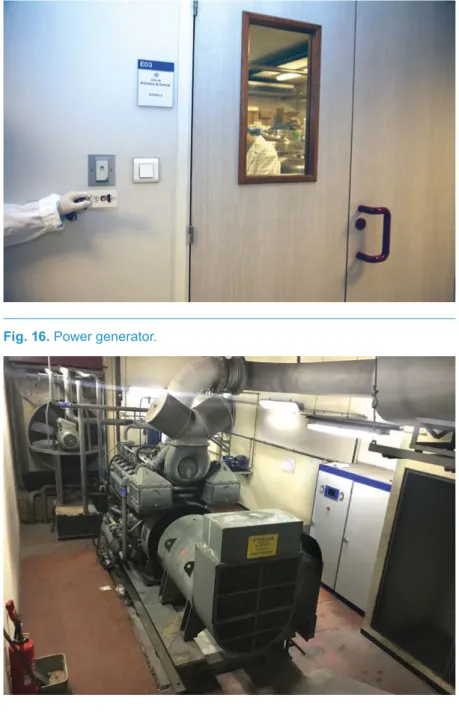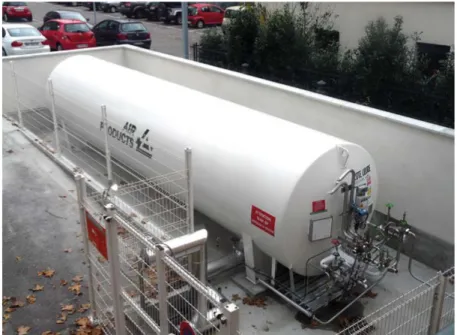COMMON MINIMUM TECHNICAL
STANDARDS AND PROTOCOLS
FOR BIOBANKS DEDICATED
TO CANCER RESEARCH
MAIMUNA MENDY, ELODIE CABOUX, RITA T. LAWLOR, JESSICA WRIGHT, AND CHRISTOPHER P. WILD
IARC TECHNICAL
PUBLICATION NO. 44
COMMON MINIMUM TECHNICAL
STANDARDS AND PROTOCOLS
FOR BIOBANKS DEDICATED
TO CANCER RESEARCH
MAIMUNA MENDY, ELODIE CABOUX, RITA T. LAWLOR, JESSICA WRIGHT, AND CHRISTOPHER P. WILD
IARC TECHNICAL
PUBLICATION NO. 44
Published by the International Agency for Research on Cancer, 150 cours Albert Thomas, 69372 Lyon Cedex 08, France
©International Agency for Research on Cancer, 2017 Distributed by
WHO Press, World Health Organization, 20 Avenue Appia, 1211 Geneva 27, Switzerland (tel: +41 22 791 3264; fax: +41 22 791 4857; email: [email protected]).
Publications of the World Health Organization enjoy copyright protection in accordance with the provisions of Protocol 2 of the Universal Copyright Convention. All rights reserved.
The designations employed and the presentation of the material in this publication do not imply the expression of any opinion whatsoever on the part of the Secretariat of the World Health Organization concerning the legal status of any country, territory, city, or area or of its authorities, or concerning the delimitation of its frontiers or boundaries.
The mention of specific companies or of certain manufacturers’ products does not imply that they are endorsed or recommended by the World Health Organization in preference to others of a similar nature that are not mentioned.
Errors and omissions excepted, the names of proprietary products are distinguished by initial capital letters. The authors alone are responsible for the views expressed in this publication.
The International Agency for Research on Cancer welcomes requests for permission to reproduce or translate its publications, in part or in full. Requests for permission to reproduce or translate IARC publications – whether for sale or
for non-commercial distribution – should be addressed to the IARC Communications Group, at: [email protected]. Cover image: Paraffin-embedded tissues processed and stored within the context of various IARC research projects
(Credit: R. Dray/IARC).
This book is also available in electronic format from http://publications.iarc.fr.
IARC Library Cataloguing in Publication Data
Common minimum technical standards and protocols for biobanks dedicated to cancer research / Maimuna Mendy, Elodie Caboux, Rita T. Lawlor… [et al.]
(IARC Technical Publications; 44)
1. Biological Specimen Banks – Standards 2. Biological Specimen Banks – Organization & Administration 3. Biological Specimen Banks – Methods 4. Neoplasms
I. Mendy, M. II. Title III. Series
ISBN 978-92-832-2463-1 (NLM Classification: W1) ISSN 1012-7348
Contributors ... iv Acknowledgements ... v Foreword ...vi Preamble ... vii Abbreviations ... ix Section 1 ...1
Glossary and definitions Section 2 ... 5
Role of biobanks in cancer research Section 3 ...11
Recommendations for biobanks Section 4 ... 55
Selected protocols References ... 63
Annex 1 ... 69
IARC policy on access to human biological materials Annex 2 ... 75
Guidelines for informed consent Annex 3 ... 80
Template consent form for biobanking Annex 4 ... 91
Template Material/Data Transfer Agreement (MTA/DTA) Annex 5 ... 97
Biobank, collection, study, and sample minimum data set and associated standards Disclosures of interests ... 101
Contributors
Authors
Dr Maimuna Mendy
Head, Laboratory Services and Biobank Group
International Agency for Research on Cancer (IARC)
Lyon, France Dr Elodie Caboux Laboratory Services and Biobank Group
International Agency for Research on Cancer (IARC)
Lyon, France Dr Rita T. Lawlor
ARC-NET Centre for Applied Research on Cancer
University of Verona Verona, Italy Dr Jessica Wright
Study Manager, Sheffield Clinical Trials Research Unit
The University of Sheffield Sheffield, United Kingdom Dr Christopher P. Wild
Director, International Agency for Research on Cancer (IARC) Lyon, France
Reviewers
The authors are grateful to the following expert colleagues who contributed comments, advice, corrections, and protocols in the preparation of this book.
Dr Joakim Dillner Karolinska Institutet Stockholm, Sweden Ms Marianne Henderson Senior Advisor for Division Resources, Office of the Director, Division of Cancer Epidemiology and Genetics
Senior Advisor on Biobanking, Center for Global Health, National Cancer Institute, National Institutes of Health, Division of Health and Human Services
Rockville, MD, USA Dr Jan-Eric Litton
Director General, Biobanking and BioMolecular resources Research Infrastructure–European Research Infrastructure Consortium (BBMRI-ERIC)
Graz, Austria Dr Manuel Morente
Biobank Scientific Director, Spanish National Cancer Research Centre (CNIO)
Coordinator, Spanish National Biobank Network
Past-President, European, Middle Eastern and African Society for Biopreservation and Biobanking (ESBB)
Madrid, Spain Dr Sabina Rinaldi
Biomarkers Group, Section of Nutrition and Metabolism
International Agency for Research on Cancer (IARC)
Lyon, France
Dr Ghislaine Scélo
Genetic Epidemiology Group, Section of Genetics
International Agency for Research on Cancer (IARC)
Lyon, France
Ms Anne-Marie Tassé Executive Director, Public Population Project in Genomics and Society (P3G) Montreal, Canada
Dr Jim Vaught
President, International Society for Biological and Environmental Repositories (ISBER)
Editor in Chief, Biopreservation and Biobanking
Senior Research Fellow,
International Prevention Research Institute, Lyon, France
Dr Kurt Zatloukal
Deputy Head, Institute of Pathology Medical University of Graz
Graz, Austria Mr Ma’n H. Zawati
Executive Director, Centre of Genomics and Policy McGill University Montreal, Canada
Production Team
Karen Müller English Editor Sylvia Lesage Publishing AssistantWe would like to acknowledge the authors of Common Minimum Technical Standards and Protocols for Biological Resource Centres Dedicated to Cancer Research (published by IARC in 2007): an IARC Secretariat composed of Dr Elodie Caboux, Dr Amelie Plymoth, and Dr Pierre Hainaut, joined by the Working Group participants.
The authors would like to thank Ms Sally Moldan, for her excellent contribution towards the compilation of this book, and the members and partners of the Low- and Middle-Income Countries (LMICs) Biobank and Cohort Building Network (BCNet), for sharing their real-life experiences working in resource-constrained settings.
Foreword
Biological specimens collected, processed, and stored under opti-mal conditions increasingly provide a necessary foundation for cancer research. Information obtained from such samples opens opportunities to learn more about the causes, prevention, and treatment of the disease. International comparisons made possible by the study of sam-ple collections from different parts of the world are also invaluable in the pursuit of the evidence base for can-cer control.
However, the above-mentioned opportunities are accompanied by many challenges and potential pit-falls. At times, pragmatic decisions have to be made in response to the constraints faced when conducting clinical or population-based studies. These constraints may be techni-cal, may relate to infrastructure or finance, or may be ethical, legal, or social in nature. Being unaware of these types of risk to successful biobanking can place important sci-entific advances in jeopardy.
In this context, it is a great plea-sure to introduce this publication
from the International Agency for Research on Cancer (IARC). The purpose of the text is to provide clear and practical advice on the common practices needed to create and maintain biobanks, recognizing that the circumstances faced by the curators of biobanks vary across the world. The international coop-eration that went into formulating these Common Minimal Technical Standards provides confidence that the content is realistic, while at the same time maintaining the minimal standards needed in order for the biospecimens to be valid and to yield the reliable research data be-ing sought. In providbe-ing this Fore-word, I would like to place on record my thanks to all authors and review-ers who have contributed to this final product, as well as to all the contrib-utors to Common Minimum Techni-cal Standards and Protocols for Bio-logical Resource Centres Dedicated to Cancer Research, known as the “Green Book”, published by IARC in 2007.
In publishing this book, my hope is for a balanced focus, not only on
what goes into a biobank but also on what comes out. There is a risk that biobanks remain untouched or un-derexploited, a deposit that is rarely put to work for the common good. While this book aims to ensure that what goes into a biobank is of high quality and well managed, it has as its ultimate objective to drive the use of those same biospecimens in re-search. This will involve the analysis of biospecimens, but to maximize the benefits it will also require linkage to other well-documented epidemio-logical and clinical data sets. In this period of spiralling numbers of can-cer cases and costs of cancan-cer care, the failure to use stored samples to answer critical research questions is indefensible.
In conclusion, I trust that readers will find this publication to be a sup-port to successful biobanking and will find herein one important foun-dation for cancer research in the 21st century.
Dr Christopher P. Wild
Director, International Agency for Research on Cancer
Preamble
The International Agency for Research on Cancer (IARC) pub-lished Common Minimum Technical Standards and Protocols for Biologi-cal Resources Centres Dedicated to Cancer Research, known as the “Green Book”, in 2007. The recom-mendations and protocols in that publication were largely based on guidelines, procedures, and docu-mentation on biorepositories devel-oped by several working groups, institutions, regulatory bodies, and organizations, including the World Health Organization.
However, biobanking has devel-oped at a rapid pace over the years, driven mainly by the push for person-alized medicine, the need for high-quality biological resources and as-sociated data for scientific research, and technological advancement of analytical platforms for molecular and genetic research. These devel-opments have enabled the collec-tion and analysis of large numbers of biospecimens in combination with epidemiological and clinical data collected across populations and in-volving multiple biobanks.
In response to these develop-mental changes and to promote col-laborative projects, a wide range of biobanking stakeholders are estab-lishing approaches and mechanisms for the harmonization of resources, including data. These stakehold-ers include international organiza-tions, societies, and instituorganiza-tions, such as the United States National Cancer Institute (NCI), the Interna-tional Society for Biological and En-vironmental Repositories (ISBER), the European, Middle Eastern and African Society for Biopreserva-tion and Biobanking (ESBB), and the Biobanking and BioMolecular resources Research Infrastructure– European Research Infrastructure Consortium (BBMRI-ERIC). Their activities include the improvement of biobanking protocols and standards to provide high-quality samples and to adequately address ethical, legal, and social issues (ELSI).
This IARC Technical Publica-tion includes guidelines and recom-mendations for biobanks not only in high-income countries but also in low- and middle-income countries
(LMICs). The recommendations are based on validated and/or evidence-based guidelines, taking into account the current knowledge of biobanking practices and standards resulting from projects such as Standardisa-tion and Improvement of Generic Pre-analytical Tools and Procedures for In Vitro Diagnostics (SPIDIA), BBMRI– Large Prospective Cohorts (BBMRI-LPC), and the International Geno-mics Consortium (IGC), as well as the European Committee for Standard-ization (CEN) Technical Specifica-tions for molecular in vitro diagnostic examinations and International Or-ganization for Standardization (ISO) norm 15189 (ISO, 2012). ISO 15189 is currently under revision (https://www. iso.org/obp/ui/#iso:std:iso:15189:ed-3:v2:en), and the working groups of the Technical Committee of ISO 276 (http://www.iso.org/iso/home/ standards_development/list_of_iso_ technical_committees/iso_technical_ committee.htm?commid=4514241) are dealing with biobanking qual-ity issues, including terminology, bioresearch, bioprocessing, pre- analytical methods, isolation of
analytes, and data processing and integration.
This book also includes sections on sample sharing, ELSI, and harmo-nization guidelines important to sup-port collaborative research efforts that make use of biological materi-als. In particular, the section on open access deals with the principles of sharing and provides recommenda-tions for biobanks in relation to sam-ple and data sharing, which is key to establishing research collaboration. The section on governance provides guidelines on governance structures for biobanks for transparent and
ef-fective running of the facilities. Tem-plates for informed consent and Ma-terial and Data Transfer Agreements are available in the Annexes section.
This new book also benefits from the experience and knowl-edge gained by IARC from coordi-nating the LMICs Biobank and Co-hort Building Network (BCNet) and managing an international biobank, which contains diverse collections of specimens and data drawn from studies across the world, including the European Prospective Inves-tigation into Cancer and Nutrition (EPIC) collection.
The guidelines and recommen-dations are applicable to biobanks operating in different geographical locations, and although the book’s focus is on biobanks dedicated to cancer research, the principles and guidelines outlined here are also applicable to non-cancer biobanks.
Table 1 presents a list of the main sources of information used to develop the recommendations presented in this book. Whenever appropriate, the book indicates ref-erences and links to more extensive documentation and protocols.
Table 1. Guidelines, procedures, and documentation on biobanks
Title Authors/origin
Tissue banking for biomedical research National Cancer Centre Singapore
Biorepository protocols Australasian Biospecimen Network (ABN)/Australia
Standardizing tissue collection and quality control procedures for a
European virtual frozen tissue bank network European Human Frozen Tumour Tissue Bank (TuBaFrost)
Human tissue and biological samples for use in research: operational
and ethical guidelines Medical Research Council (MRC)/United Kingdom
2012 Best practices for repositories: collection, storage, retrieval, and
distribution of biological materials for research International Society for Biological and Environmental Repositories (ISBER)/International
NCI best practices for biospecimen resources National Cancer Institute (NCI)/USA
Guidance on regulations for the transport of infectious substances World Health Organization (WHO)/International
United Nations recommendations on the transport of dangerous goods,
model regulations, 19th revised edition United Nations Economic Commission for Europe (UNECE)/International
Recommendation Rec(2006)4 of the Committee of Ministers to Member
States on research on biological materials of human origin Council of Europe Committee of Ministers
Collection, transport, preparation, and storage of specimens for
molecular methods: approved guideline Clinical and Laboratory Standards Institute (CLSI)/USA
The Human Proteome Organization Human Proteome Organization (HUPO)
Case studies of existing human tissue repositories: “best practices” for
a biospecimen resource for the genomic and proteomic era RAND Corporation/USA
Biological resource centres: underpinning the future of life sciences and
biotechnology Organisation for Economic Co-operation and Development (OECD)/International
OECD best practice guidelines for biological resource centres Organisation for Economic Co-operation and Development (OECD)/
International Standard operating procedure for the collection of fresh frozen tissue
ACD acid citrate dextrose
BBMRI-ERIC Biobanking and BioMolecular resources Research Infrastructure–European Research Infrastructure Consortium
BBMRI-LPC BBMRI–Large Prospective Cohorts
BCNet LMICs Biobank and Cohort Building Network BRIF Bioresource Research Impact Factor
BRISQ Biospecimen Reporting for Improved Study Quality CEN European Committee for Standardization
CO2 carbon dioxide CSF cerebrospinal fluid DBS dried blood spot DEPC diethylpyrocarbonate DIN DNA integrity number DMSO dimethyl sulfoxide DNA deoxyribonucleic acid DR disaster recovery dsDNA double-stranded DNA DTA Data Transfer Agreement EDTA ethylenediaminetetraacetic acid ELSI ethical, legal, and social issues
EPIC European Prospective Investigation into Cancer and Nutrition
ESBB European, Middle Eastern and African Society for Biopreservation and Biobanking
EU European Union
FBS fetal bovine serum
FFPE formalin-fixed, paraffin-embedded GA4GH Global Alliance for Genomics and Health gDNA genomic DNA
HBV hepatitis B virus
HIV human immunodeficiency virus
IARC International Agency for Research on Cancer IATA International Air Transport Association ICAO International Civil Aviation Organization
ISBER International Society for Biological and Environmental Repositories ISO International Organization for Standardization
IT information technology
LIMS laboratory information management system LMICs low- and middle-income countries
LN2 liquid nitrogen
MIABIS Minimum Information about Biobank Data Sharing miRNA microRNA
MTA Material Transfer Agreement
NCI United States National Cancer Institute NIH United States National Institutes of Health OCT optimal cutting temperature
OECD Organisation for Economic Co-operation and Development P3G Public Population Project in Genomics and Society PCR polymerase chain reaction
QA quality assurance QC quality control
QMS quality management system qPCR quantitative PCR
R&D research and development RIN RNA integrity number RNA ribonucleic acid rRNA ribosomal RNA
RT-PCR reverse transcription PCR SOPs standard operating procedures SPREC Sample PREanalytical Code ssDNA single-stranded DNA TNM tumour–node–metastasis
TuBaFrost European Human Frozen Tumour Tissue Bank UNECE United Nations Economic Commission for Europe UV ultraviolet
SE C TI O N 1 SE C TI O N 1
section
1
.
Glossary and definitions
Aliquot
Aliquoting is a process in which a specimen is divided into separate parts, which are typically stored as individual samples. The term “ali-quot” may also be used as a noun to denote a single sample. It is ad-visable to store aliquots in separate containers, to minimize loss due to unexpected equipment failure.
Analyte
A substance or chemical constituent that is determined in an analytical procedure.
Annotation
Additional information associated with a particular point in a document or other piece of information.
Anomaly
An unexpected event occurring with-in the quality management system, Unless otherwise defined in
an-other context in this book, important terms are defined below.
Some of the definitions are ac-cording to the 2012 International So-ciety for Biological and Environmen-tal Repositories (ISBER) guidelines (ISBER, 2012).
It should be noted that the Inter-national Organization for Standard-ization (ISO) standards that are cur-rently under development and will be released within 2 years (ISO/TC 276 Biotechnology) will include a section on biobanking definitions.
Adverse event
Any event that caused harm or had the potential to cause harm to any biobank personnel or visitors, in-cluding but not limited to breach of security of the premises and its con-tents, or harm to biospecimens or data integrity or linkage.
usually detected by staff of the area in which the event occurred, which may result in non-compliance with the quality management system or with the requirements of the user.
Anonymization
The process in which identifying information or details are re- moved from the data collected with a sample, so that the sample donor remains anonymous.
Associated data
The clinical, pathological, and epide-miological information related to pa-tients who provided a sample. The information relates to characteristics of the sample, the study participant, and biological experiments that can be used to generate knowledge.
Autopsy
that can affect human health. It can also include substances harmful to animals.
Biological resource
A collection of biological specimens and associated data that are ac- quired for a defined purpose. The custodian of the collection is re-sponsible for the management of the biological resource. Biological re-sources may be stored in a biobank or laboratory and in databases, de-pending on the number of samples, the volume of information, and the governance structure of the biobank.
Biological safety hood
A cabinet designed to provide a mi-crobe-free work environment, which enables work on samples in an isolated area.
Biorepository
See “Biobank”.
Coding
Substituting a code for personally identifying information in such a way that linkage is only possible through a key.
Cold chain
A temperature-controlled supply chain.
Cold ischaemia
The condition of a tissue sample af-ter its removal from the body until its stabilization or fixation.
Collection
The practice or technique of collect-ing a specimen, or a specific sam-ple or group of samsam-ples, that has been isolated for future research purposes.
Consignee
Any individual, agency, institution, or organization that receives speci-mens and assumes responsibility for storing, dispensing, and tracking the disposition of specimens.
organs and tissues of a body, to de-termine cause of death or pathologi-cal conditions.
Biobank
Infrastructure for the collection, ar-chiving, and storage of biospeci-mens and their associated data, and the procedures and related servic-es connected to the biospecimens and associated data. The services include informing individuals who are approached to participate in a study, obtaining their consent, col-lecting and processing specimens for secure long-term storage, ac-cessing and retrieving specimens appropriate for analysis, processing for preparation of biomaterials (e.g. DNA, RNA, proteins), quality con-trol, and packaging and shipping of specimens. Many types of biobank are relevant to cancer research. They include, among others, tumour and tissue biobanks for specimens and data obtained in the course of normal clinical procedures; special-ized collections of specimens and data developed in the context of clinical trials, mechanistic studies, or diagnostic or prognostic studies; and collections of specimens and data developed in epidemiologi-cal studies and biomarker studies. Biobank samples include tissues, blood, cell lines, DNA, and pro-teins derived from individuals with a history of hereditary or familial cancer. Biobanks are also known as biorepositories.
Biobanking
The process of storing material or specimens and associated data for future use.
Biohazard
An organism, or a substance de-rived from an organism, that poses a threat to (primarily) human health. This can include medical waste and samples of a microorganism, virus, or toxin (from a biological source)
Container
An enclosure for one or more units of a specimen or specimens.
Controlled areas
Restricted work areas of low micro-bial and particulate content in which non-sterile materials are prepared.
Custodian
The person responsible for the management of a biological re-source. The custodian works with other key stakeholders in the man-agement of the resource, including the tracking of all relevant documen-tation for the resource, and is re-sponsible for ensuring that policies on access to the resource are in place and are implemented accord-ing to appropriate guidelines.
Database
A structured collection of records or data that is stored in a computer system so that a computer program or a person using a query language can consult it to answer queries.
Dehydration
The removal of water from a tissue.
De-identification
A process that ensures that a per-son’s identity cannot be connected with information or samples donated by them.
Desiccant
A desiccant is a hygroscopic sub-stance that induces or sustains a state of dryness (desiccation) in its vicinity. Commonly encountered pre-packaged desiccants are solids that absorb water.
Deviation
An intentional or unintentional event that departs from a set procedure or normal practice.
Dewar
SE C TI O N 1
liquefied gases. A dewar may also be referred to as a dewar flask or dewar vessel, or a liquid nitrogen tank.
Distribution
A process that includes receipt of a request for specimens, selection of appropriate specimens, and final inspection, in conjunction with subsequent shipment and delivery of specimens to another biobank, specimen collection centre, or laboratory.
Donor
A person who donates or gives an organ, blood, or blood products to another person.
Dry ice
Solid-phase carbon dioxide (CO2). CO2 solidifies at −78.5 °C.
End user
A health-care practitioner, scien-tist, or laboratory staff member who performs an appropriate procedure, test, or archival function.
Error
A deviation from a standard operat-ing procedure (SOP) duroperat-ing speci-men retrieval, processing, testing, quarantining, labelling, storage, or distribution that might adversely affect the specimen.
Ethical, legal, and social issues (ELSI)
The ethical, legal, and social issues associated with the development and operation of a biobank.
Identifier
Information (e.g. name, social se-curity number, medical record number, or pathology accession number) that would enable the iden-tification of the subject. For some specimens, this information might include the taxon name and the collection number.
Incident
Any unplanned occurrence that deviates from standard operating procedures (SOPs) or applicable government laws and regulations during specimen retrieval, process-ing, labellprocess-ing, storage, or distribution that may affect subsequent use of those specimens.
Individual
The person who is the subject of pro-tected health information.
Informed consent
A decision to participate in research, taken by a competent individual who has received the necessary in-formation; who has adequately un-derstood the information; and who, after considering the information, has arrived at a decision without having been subjected to coercion, undue influence, inducement, or intimidation.
Institution
The body responsible for speci-men collection and archiving that commits itself to the development, management, and long-term main-tenance of a biobank. Although the organizational nature of such insti-tutions may vary widely, they are primarily clinical cancer centres, academic medical centres, research institutes closely associated with clinical centres, or central organiza-tions dedicated to the management of biobanks.
Institutional review board (IRB)
See “Research ethics committee (REC)”.
Label
Any written, printed, or graphic mate-rial on or affixed to a specimen con-tainer or package.
Liquid nitrogen (LN2)
Coolant used to cool and store samples. Nitrogen becomes liquid
at −196 °C. Samples stored in the vapour phase of liquid nitrogen are −190 °C and warmer, depending on the distance from the liquid phase.
Liquid nitrogen tank
See “Dewar”.
Lyophilized
Dehydrated for storage by conver-sion of the water content of a frozen specimen to a gaseous state under vacuum. Also called “freeze-dried”.
Material Transfer Agreement (MTA)/ Data Transfer Agreement (DTA)
An agreement or contract that gov-erns the transfer of research materi-als and/or data between two organi-zations, when the recipient intends to use them for research purposes. It defines the rights and obligations of the provider and the recipient with respect to the use of the materials and/or data.
Monitoring system
A system that monitors the temper-ature and environmental conditions, including alarms, in conjunction with remote access, security features, and electronic data storage.
Participant
A person who takes part in a trial. Participants must usually meet cer-tain eligibility criteria.
Patient
A person who receives medical at-tention, care, or treatment.
Pre-analytical data
Factors that may have an impact on the integrity of the sample during the collection, processing, and storage processes. These data include infor-mation on the treatment of the sam-ple, including the conditions and the duration of the treatment.
Preservation
in environmental conditions, or oth-er means during processing and storage to prevent or retard bio- logical or physical deterioration of a specimen.
Procedure
A series of steps that, when followed in order, are designed to result in a specific outcome.
Processing
Any procedure used after specimen collection but before distribution, including preparation, testing, and releasing the specimen to inventory and labelling.
Pseudo-anonymization
The process whereby identifiable personal information is anonymized, but in such a way that the per- sonal identifiers are replaced by one pseudonym, which can be linked across multiple data records without revealing the identity of the person.
Quality
Conformance of a specimen or pro-cess with pre-established specifica-tions or standards.
Quality assurance (QA)
An integrated system of manage-ment activities involving planning, implementation, documentation, as- sessment, and improvement to ensure that a process or item is of the type and quality needed for the project.
Quality control (QC)
The system of technical activities that measures the attributes and perfor-mances of a process or item against defined standards, to verify that the stated requirements are fully met.
Quality management system (QMS)
The organizational structure, pro-cedures, processes, and resourc-es needed to implement quality management.
Re-identification
A reversible process that allows data from which identifiers have been removed, and replaced by a code, to be re-identified and linked to a specific individual by, for example, using the code or linking different data sets.
Removal
See “Retrieval”.
Repository
An entity that receives, stores, pro-cesses, and/or disseminates speci-mens, as needed. This term encom-passes the physical location as well as the full range of activities associ-ated with its operation. A repository may also be referred to as a bio- repository or a biobank.
Research ethics committee (REC)
A board, committee, or other group formally designated by an institution to review the ethical, legal, social, scientific, and financial implications of biomedical research involving humans as subjects, to approve the initiation of the research, and to conduct periodic reviews of such re-search. In some countries, this body is known as an institutional review board (IRB) or a research ethics board (REB).
Retrieval
The removal, acquisition, recov-ery, harvesting, or collection of specimens.
Safety
Processes, procedures, and tech-nologies to ensure freedom from danger or harm.
Sample
A single unit containing material derived from one specimen.
Shipping manifest
A written description of the contents of a shipped package.
Snap-freezing
The process by which the temper- ature of samples is lowered very rap-idly to below −70 °C using dry ice or liquid nitrogen.
Specimen
A specific tissue sample, blood sam-ple, and so on taken from a single subject or donor at a specific time.
Standard operating procedures (SOPs)
A set of detailed written instructions to achieve uniformity of the perfor-mance of a specific function.
Storage
Maintenance of specimens under specified conditions for future use.
Subject
A living or deceased individual who is the source of the specimen in ac-cordance with established medical criteria, procedures, and privacy reg-ulations. In some countries, the term “Donor” or “Individual” may be used in the same context as “Subject”, especially in the context of human specimens.
Traceability
The ability to locate a specimen dur-ing any step of its donation, collec-tion, processing, testing, storage, and disposition.
Warm ischaemia
The condition in which the tissue is deprived of its normal blood supply, containing oxygen and nu-trients, while the tissue is at body temperature.
The role of biobanks in biological research in general and their impact on medical, societal, and economic issues have been discussed in two reports from the Organisation for Economic Co-operation and Devel-opment (OECD) (OECD, 2007, 2009). The OECD publications address the importance, justification, and sustain-ability of developing biobanks for re-search. In 2014, the Biobanking and BioMolecular resources Research Infrastructure–European Research Infrastructure Consortium (BBMRI- ERIC), an umbrella organization for biobanking in Europe, was estab-lished to provide a focal point for biobanking activities in Europe and to provide fair access to quality-con-trolled human biological samples and associated data for cross-biobanking research (van Ommen et al., 2015; Mayrhofer et al., 2016).
2.1 Importance of biobanks
2.1.1 Biobanks are critical for
cancer research
Human biological specimens have been used for many decades for translational purposes in cancer re-search, to investigate disease patho-genesis, to test scientific hypotheses, and to assess biomarkers identified in experimental studies. The advent of new technologies opens unprec-edented opportunities to assess the status of the human genome and its expression, the complex networks of interactions between biomolecules, and the functional and clinical con-sequences of their alteration (NCI, 2016).
Therefore, studies on human specimens are also becoming critical for the process of discovering new
mechanisms involved in causing can-cer or in determining its progression, resistance or response to treatment, and clinical outcome (Riegman et al., 2006a).
Biobanks are the foundation of three rapidly expanding domains of biomedical science:
• molecular and genetic epidemiolo-gy (aimed at assessing the genetic and environmental basis of cancer causation in the general population as well as in families);
• molecular pathology (aimed at de-veloping molecular-based classifi-cation and diagnostic procedures for cancers); and
• pharmacogenomics/pharmacopro-teomics (aimed at understanding the correlation between an in-dividual patient’s genotype or phenotype and response to drug treatment).
section
2
.
Role of biobanks in
cancer research
SE C TI O N 22.1.2 Biobanks are important
for developing personalized
medicine and/or precision
medicine
With conventional diagnostic meth-ods, risk factors of importance, as well as the opportunity to prevent diseases that may emerge later, are often overlooked when the focus is on the symptoms manifested. Collecting and analysing biological specimens is a necessary procedure for pathol-ogy-based diagnosis and to enable patients to benefit from the applica-tions of molecular and genetic cancer research.
Personalized medicine and pre-cision medicine are transforming di-agnosis in medicine and are leading towards patient-centred and multifac-eted diagnostics (Hall et al., 2011).
Personalized medicine is an emerging practice of medicine that uses an individual’s genetic and en-vironmental profile to guide decisions made about the prevention, diagno-sis, and treatment of disease. This concept has been refined and its scope expanded to include the ap-proaches, decisions, and practices in medical facilities, resulting in the new term “precision medicine”.
Precision medicine is defined by the United States National Insti-tutes of Health (NIH) as “an approach to disease treatment and prevention that seeks to maximize effectiveness by taking into account individual var-iability in genes, environment, and lifestyle” (Precision Medicine Initiative Working Group, 2015). In precision medicine, genomic and epigenomic analyses with associated data can be used to define individual patterns of disease and susceptibility. Perform-ing molecular-based assessments may become a systematic require-ment at different stages of patient follow-up, potentially leading to
bet-ter individual prevention, diagnosis, prognosis, treatment, and monitoring.
2.1.3 Biobanks have an
impact on biotechnological
and medical innovation
In the continuum from laboratory dis-covery to medical application, bio-banks play a key role in life science research and development (R&D). Progress in medicine depends on innovation, development, and the translation of laboratory findings into clinical practice. Access to human biological specimens and associat-ed data is often a prerequisite for such R&D advances.
Therefore, the development of high-quality biobanks with innovative research platforms has accelerated and facilitated this translational pro-cess. This is due mainly to techno- logical advances and reductions in the cost of information technology (IT), used for data storage and for the assembly, evaluation, and analysis of large numbers of samples, as well as increases in analytic capabilities and the drastically reduced costs of DNA sequencing, with results available within a shorter time frame. Simi-lar advances in mass spectrometry have drastically lowered the cost and expanded the ability to characterize proteins and the metabolites present in biological samples.
2.1.4 Importance of
networking and exchanges
between biobanks
Cancer is a burden faced by people across the globe. Occurrence and mortality rates vary in different parts of the world. In addition, studies of many rare forms of cancer are limited by the difficulty of recruiting a suffi-cient number of cases within any sin-gle collection centre, or even within one country.
Networking, or harmonizing, of biobanks can encourage the
col-lection of higher-quality samples and data, enable larger research projects to take place, and reduce duplication of effort (Yuille et al., 2008; Harris et al., 2012). For can-cer biobanks, networking can en-able the study and classification of rare cancers; a cancer type is considered rare if fewer than 5 cas-es are diagnosed in a population of 10 000, and rare cancers make up at least 20% of new cancer cases (ESMO, 2010; van Ommen et al., 2015; Mayrhofer et al., 2016).
Networking implies a multidirec-tional flow of information, expertise, and biological materials between cancer centres and research insti-tutions and requires the adoption of common technical standards for specimen collection, storage, and annotation, and for data collection and management. Biobanks have an important role in facilitating such exchanges and in providing logis-tics and infrastructure for multi- centre research projects involving cancer centres, academic medical centres, and diagnostic and health- care facilities. Biobank networks involved in the collection, process-ing, storage, and dissemination of biological specimens can range from small operations with single projects in research or university laboratories to large operations in hospital, academic, or commercial biobanks. National, regional, and international networks are also de-veloping to provide resources from diverse populations. For example, the Low- and Middle-Income Countries (LMICs) Biobank and Cohort Building Network (BCNet), coordinated by the International Agency for Research on Cancer (IARC), has established a virtual catalogue to document the resources of its members.
The operational model and gov-ernance of networks depend on their focus and mission. One such model is the federated model, where the bio-banks maintain their samples and
contribute to a common network project when necessary. Another model is the project-based model, where the biobanks collect samples for a specific project (Vaught et al., 2009).
Several factors can contribute to the success of a biobank network. They include:
• well-defined goals, effective coor-dination, and funding mechanisms; • efficient communication between
the relevant medical disciplines and the global scientific community; • standard operating procedures
(SOPs), compatible informatics systems, and harmonized informed consent and material transfer poli-cies and procedures; and
• tools to enable de-identified, up-to-date follow-up and retrieval of information and clinical data on participants.
These tools are key to the suc-cess of biobank networks.
The European Prospective In- vestigation into Cancer and Nu-trition (EPIC) study, a popula-tion-based study that was initiated in the 1990s and coordinated by IARC, is an example of an effec-tive networked project. The project involved partners from 10 European countries and 23 EPIC centres, and each centre collected biospecimens and data. Blood samples and as-sociated data, including lifestyle and dietary information, were col-lected at baseline. Blood samples from participants in eight out of the 10 European countries are kept in the IARC central biobank. For two Scandinavian countries, blood sam-ples are kept locally.
Although EPIC has a central biobank for the baseline samples, the tissue samples from individu-als who develop cancer are kept at the centre, and this forms the EPIC federated biobank.
The EPIC study has provided opportunities for researchers to investigate lifestyle and cause of
death (Bergmann et al., 2013) as well as dietary intake in relation to mortality among people who develop different types of cancer, such as colorectal cancer (Alek-sandrova et al., 2014) and prostate cancer (Rohrmann et al., 2013), and other diseases, such as is-chaemic heart disease (Crowe et al., 2012).
2.1.4.1 Tools for effective
networking
Several important tools have been developed in recent years for effec-tive networking and resource sharing between biobanks. Some examples are the following (see also Sec-tion 3.8).
• The Minimum Information about Biobank Data Sharing model (MIABIS 1.0 and MIABIS 2.0). MIABIS 1.0 recommends the minimum data items and the format of the items required to enable the exchange of biological samples and data, and required to initiate collabora-tions between biobanks (Norlin et al., 2012). MIABIS 2.0 provides an ontology that represents the admin-istrative entities and includes data about the biobanks where specific specimens of interest are stored; this ontology can be helpful to an-swer research-relevant questions, such as those about the scope and curation status of the specimens and the contact information for cu-rators of biobanks (Brochhausen et al., 2013).
• The Sample PREanalytical Code (SPREC) (Lehmann et al., 2012) identifies and records the main pre-analytical factors that may have an impact on the quality of sampled clinical fluids and solid biospeci-mens and their simple derivatives during collection, processing, and storage. However, the SPREC tool may be less important with the re-lease in 2015 of the European Com-mittee for Standardization (CEN)
norms (CEN/TS 16826, 16827, and 16835) (CEN, 2015) and with the new ISO 276 standards, which will become available within 2 years. • The CEN norms deal with the stan-
dardization of the entire process of sample handling, from primary sample collection to analysis. They are based on studies undertaken to determine the important influenc-ing factors. The Technical Specifi- cations draw on the effort to codify and standardize the different steps in the pre-analytical phase.
2.1.4.2 Visibility and
standardized citation schemes
Being part of an international network and contributing to a global catalogue of available resources, with the pos-sibility of creating population-based biobanks, provides opportunities for biobanks to benefit from the ex-periences and tools developed for networks. Increased participation in research will result in an increase in the visibility of biobanks and their recognition as an important part of research infrastructure. These at- tributes can serve to augment the con-fidence of researchers and donors in the institutions and countries that the established resources are managed effectively and used optimally.Recently, a programme of guide-lines for reporting bioresource use and standardized citation schemes has been established to formal-ly recognize the efforts involved in generating, maintaining, and sharing high-quality bioresources.
Two current initiatives aim to put in place standardized procedures for formally recognizing the contributions of biobanks in research through ci-tations in scientific publications: the Citation of BioResources in Journal Articles (CoBRA) guidelines for the reporting of bioresource use in re-search articles (Bravo et al., 2015) and the Bioresource Research Im-pact Factor (BRIF), a standardized
SE C TI O N 2
citation scheme. Biobanks joining the BRIF citation scheme will have increased visibility and will benefit from participation in network projects (Cambon-Thomsen et al., 2011).
The formal recognition of the role of biobanks in scientific research will encourage sharing of biological re-sources and will increase the visibility of biobanks both nationally and inter-nationally.
2.2 Issues in developing
biobanks and using stored
specimens
Developing and using the resources in a biobank requires the active in-volvement of many professionals and has ethical and legal implications. Section 3.1 is dedicated to putting these ethical, legal, and social issues (ELSI) into perspective. However, it is useful to highlight some of the key documents and principles that can guide decision-making when estab-lishing a biobank. Key documents include the following:
• the WMA Declaration of Taipei on ethical considerations regarding health databases and biobanks (WMA, 2016);
• the WMA Declaration of Helsinki, which provides the general frame-work in which questions relating to medical research can be addressed (WMA, 2013);
• the more specific guidance issued by the OECD: Guidelines on Human Biobanks and Genetic Research Databases (OECD, 2009) and Best Practice Guidelines for Biological Resource Centres (OECD, 2007); • best practice principles outlined
by organizations such as the Unit-ed States National Cancer Insti-tute (NCI) (NCI, 2016) and ISBER (ISBER, 2012);
• guidance from the Global Alliance for Genomics and Health (GA4GH) (GA4GH, 2016) and the Public Pop-ulation Project in Genomics and So-ciety (P3G) (P3G, 2016); and
• European Union (EU) legislation, in-cluding the General Data Protection Regulation (European Commission, 2016).
Another useful approach derives rights and responsibilities from a set of four ethical principles guiding bio-medical research: respect for autono-my, non-maleficence (to do no harm), beneficence (to do good), and justice (Beauchamp and Childress, 2013). Protecting the rights of individuals arising from these principles includes the development of appropriate methods to obtain informed consent from a potential participant and the development of research protocols that are fully compatible with the principles of beneficence, non-ma-leficence, and justice. The institu-tions and investigators that develop and manage biobanks also have a responsibility to protect personal data, ensure biological and environ-mental safety, and make collections accessible and available for reuse for research purposes under (the con-sented) defined conditions. Access requests should take into account the non-renewable nature of the speci-mens in setting priorities for scientific use, and the distribution of specimens for research should be governed by the use of clear and documented Ma-terial Transfer Agreements (MTAs). These rights and responsibilities are further defined and addressed in the remainder of this book.
2.3 Principles for sustainable
biobanks
Developing a biobank is expensive. Added to the maintenance and run-ning costs, this can place financial strain on underresourced institutions. These constraints are a significant obstacle to developing biobanks in low- or middle-income countries and for the long-term sustainability of biobanks worldwide. Overcoming these obstacles requires a signifi-cant concerted effort of national and
international solidarity. The public sector (local and national govern-ments and international bodies and organizations) has a responsibility to contribute to the funding of the basic infrastructure of biobanks, be-cause of the important contribution of biobanking to research on global health and diseases. In contrast, the responsibility for the development and maintenance of sustainable and usable resources lies primarily with the institutions.
Institutions and the public sector should make provision for:
• infrastructure
• maintenance of infrastructure • equipment
• running costs • trained personnel
• data management systems • quality management systems (QMSs) • procedures to deal with ELSI.
In addition, users of the biobank-ing infrastructure facilities should con-tribute through cost reimbursement, for the financial and structural sus-tainability of biobanks. Thus, biobanks should establish user fees for access to human specimens, data, and ser-vices, to cover the costs of collecting, annotating, storing, retrieving, and processing the delivered biospeci-mens. However, human biospecimens should not under any circumstances be commercialized. Regardless of the role of industry in core funding, which is a matter of debate with serious im-plications, the legal responsibility and custodianship of the specimen collec-tion and storage must remain within institutions. This is because people who agree to provide their samples donate to the institution and not to researchers or individuals, and the samples will remain in the primary institution after the research project ends or the researcher leaves the organization. To ensure continuity in the management of the samples, the institution should nominate another person who will assume primary re-sponsibility for the samples.
In defining mechanisms for sus-tainability or stability, there is a need to develop safeguards for preserva-tion of participant confidentiality and protection against improper use of human biospecimens and data. In addition, the stability of biobanks re-lies heavily on the value of the stored resources, in terms of their quality and scientific relevance and the use of the samples.
Financial forecasts have demon-strated that the actual costs associ-ated with biobanking are significantly higher than recognized by researchers and funding bodies (Matharoo-Ball and Thomson, 2014). Cost recovery is essential for biobank sustainability and stability. Although each institu-tion will have to decide on the cost-re-covery model that will best serve its purposes, common elements to be considered include costs related to personnel, equipment, supplies, and service contracts.
The models should be consid-ered in the context of relationships between the users, funding agen-cies, academia, and universities, and possibly also industry partners. Contingency plans in case of unex-pected incidents and inadequate supporting infrastructure, such as flood or fire disasters, interruption in electricity supply, and poor Inter-net connectivity, should be included in any model.
2.4 General considerations
for establishing a biobank
Several factors must be taken into ac-count when setting up and running a biobank. A detailed description of these requirements is provided in the 2012 Best Practices for Repositories: Collection, Storage, Retrieval, and Distribution of Biological Materials for Research, developed by ISBER (ISBER, 2012). Some aspects of particular importance in setting up a biobank for cancer research are highlighted here.2.4.1 Institutional commitment
Many factors contribute to the deci-sion to establish and run a biobank. In practice, the process often starts with the willingness of medical doctors and scientists to develop a resource useful for diagnosis, prognosis, and research purposes. However, the establishment of a biobank must not rely only on individual action but also requires a clear commitment by the host institution, which also needs to ensure that collections are developed within appropriate legal, ethical, clin-ical, scientific, and technical guide-lines, to provide historical continuity in specimen management and record- keeping. Finally, the biobank should ensure that the stored materials can be made available for research.
The purpose of the biobank must be clearly formulated and document-ed. In case of loss of funding or other adverse events that may prevent the institution from maintaining its com-mitment, it is the responsibility of the institution to take the necessary steps, depending on the applicable legal/ethical requirements. There may be an obligation to destroy the sam-ples or to transfer the collected spec-imens and data to another institution that will take over the commitment for the long-term maintenance of the resources. There may be specific obligations related to such a transfer.
2.4.2 Ethical, legal, and social
issues (ELSI) and governance
ELSI considers local, national, and international cultural, legal, social, and ethical norms. For example, the EU Data Protection Directive states that under EU law, personal data can be gathered legally only under strict conditions, for a legitimate purpose (European Commission, 1995). Fur-thermore, people or organizations that collect and manage personal in-formation must protect it from misuse and must respect certain rights of the
data owners, which are guaranteed by EU law.
However, there are conflicting data protection rules in different countries, which need to be observed during international exchanges. Therefore, common EU rules have been established to ensure that per-sonal data have a high standard of protection everywhere in the EU. The EU Data Protection Directive also provides specific rules for the trans-fer of personal data outside the EU, to ensure the best possible protection of data when they are exported abroad.
ELSI and governance recom-mendations relating to governance structures, informed consent, data protection, return of results and inci-dental findings, and data and sample sharing are presented in Section 3.1.
An important governance issue to highlight when establishing and maintaining biobanks relates to pub-lic engagement programmes and the establishment of clear channels of communication with partners and stakeholders. Therefore, transparen-cy in procedures and operations is critical, and clear descriptions of the roles and responsibilities of person-nel should be communicated to part-ners and stakeholders. Given that participation is voluntary and that most biobanks operate on a non-economic basis, biobanks need public trust and support. It has become common practice for large-scale population biobanks to engage in consultation with the public and other stakehold-ers before the biobank is established (UK Biobank Ethics and Governance Council, 2015, 2016). Methods of communication could include, for ex-ample, consultation with community representatives, focus group meet-ings, workshops, interviews, public meetings, polls, and surveys. Public consultation is particularly important when ethnic or cultural minorities are approached to participate in biobank collections. Section 3.1 provides fur-ther information on transparency and
SE C TI O N 2
communication with key stakehold-ers, and Section 3.1.2.5 describes community engagement in relation to the consent process.
2.4.3 Biobank management
and staffing
Biobanks should be adequately staffed, and the personnel selected for these tasks must be well quali-fied and have an appropriate level of specialized training. The biobank should be placed under the overall supervision of a biobank manager with sufficient training, experience, and seniority to fulfil the scope of the activities of the biobank. The manag-er is responsible for opmanag-erations, in-cluding compliance with appropriate
regulations, and has a critical role in receiving, processing, and respond-ing to requests for access to stored specimens. The manager can act as a technical advisor to the access committee during the review of ac-cess applications.
Running a biobank requires ded-icated staff members for specimen processing and storage and for data management. The job description, tasks, and reporting system of all supervisory and technical staff mem-bers must be documented. This is of particular importance in instanc-es where biobank staff members also perform other tasks within the institution (e.g. pathology service or service activities in molecular biology). Staff members must have
adequate educational backgrounds, experience, and training to ensure that assigned tasks are performed in accordance with the biobank’s established procedures. Updated training should be conducted on a periodic basis for personnel, in ac-cordance with applicable regulations and roles within the biobank.
Other personnel who are not nec-essarily staff members of biobanks but should be aware of the purpose and goals of obtaining high-quality bioresources are clinicians, research-ers, technicians, nurses, surgeons, pathologists, and anaesthetists. The involvement of a pathologist in this process is crucial to ensure that patient care is not compromised (NCI, 2016).
3.1 Ethical, legal, and social
issues (ELSI) and governance
This section provides advice on developing an internal governance system for biobanks. It references recommendations and best prac-tices of international organizations, including OECD (2007, 2009), ISBER (2012), GA4GH (2016), and NCI (2016), among others. However, the background of law and guidance is continually developing and should be monitored. For example, the new EU General Data Protection Regulation (European Commission, 2016) has implications for patients’ rights in medical research, CEN norms, and ISO standards.Governance, in the context of bio-banks, is not one-size-fits-all. During the establishment of a biobank, gov-ernance systems should be designed to take into account the biobank’s scope and the context in which it
operates (Laurie, 2011). A good inter-nal governance system should: • ensure that the biobank remains
faithful to its purpose, encour-aging trust between the various stakeholders;
• be guided by a set of overarching principles when making decisions, including being transparent, ac-countable, consistent, proportion-ate, efficient, coordinated, equita-ble, and fair; and
• be dynamic and able to adapt over time.
The internal governance ap-proaches introduced in this section are based on a good governance structure or framework (Section 3.1.1) and documentation on:
• informed consent (Section 3.1.2); • data protection, confidentiality, and
privacy (Section 3.1.3);
• return of results and incidental find-ings (Section 3.1.4); and
• access to and sharing of samples
and data (Section 3.1.5; see also Annex 1).
Further sections consider quality (Section 3.4) and records manage-ment (Section 3.6).
Good governance includes en-gaging with the public during the establishment of a biobank and throughout the life-cycle of the bio-bank. Therefore, the approach to public engagement must be con-sidered from the outset. In addition to engaging with participants, the biobank may need to engage with the scientific community, research-ers, patient groups, and/or the wid-er public using a variety of meth-ods, for example by consultation on study designs and policies, in-volvement on committees, or publi-cation and outreach. Good biobank governance also includes a strong commitment to researchers, ensur-ing quality, efficiency, and trans-parency of service. Therefore, the
section
3
.
Recommendations
for biobanks
SE C TI O N 3 SE C TI O N 312
following recommendations should be put into practice in collaboration with project principal investigators.
3.1.1 Governance framework
A good governance framework should define the organizational structure of the biobank, for daily management and oversight of its strategic policy. This framework usu-ally includes lists and descriptions of the biobank’s personnel, commit-tees, and policies that are required to enable the correct functioning of the biobank. The level of policies and procedures governing the bio-bank should be scalable to its na-ture, size, and available resources. For example, smaller biobanks may have more limited policies, whereas
larger biobanks will need to develop a detailed protocol and procedures.
The policies are usually stipulat-ed in a governance document that describes the objectives and scope of the biobank, the organizational structure, the scientific and eco-nomic strategy of the biobank (which will be articulated in an annually up- dated business plan), and contingen-cy plans in the event of closure. The governance document also includes policies on data protection and pri-vacy as well as the procedures gov-erning specific operational activities of the biobank.
Defining the structure and man-date of committees and describing policies is an effective way to en-sure adherence to proper gover- nance. However, if there are too
many committees or policies, or if they are ill-defined, this can impede procedures and cause delays.
3.1.1.1 Governance organization
The biobank should have a structure of committees and appropriately quali-fied personnel in relevant roles to over-see its governance. The size, type, and number of committees and their composition will vary depending on the size and purpose of the biobank. Care-ful consideration should be given when participants, patient groups, or public representatives are asked to serve on biobank committees. Their roles on the committee should be clearly communicated, and training should be provided. The following types of committee may be considered (Fig. 1).Fig. 1. Sample committee structure for internal biobank governance.
Scientific oversight committee Ethics oversight committee
Laboratory safety and biosecurity committee Data and sample access committee
Public engagement committee Quality management committee Operations or management committee
Biobank executive committee or steering group
Other committees:
Executive committee or steering group
All biobanks should have an execu-tive committee or steering group. The responsibilities of this committee may include overall management, defin-ing strategic objectives, monitordefin-ing progress, revising and/or adopting policies, and developing a commu-nications strategy. This committee may also conduct an annual review meeting to consider the QMS. Ethics oversight (or advisory) committee
The ethics oversight committee ad-vises the executive committee on strategy, developments, and proce-dures relating to ethical oversight, in-cluding legal and policy issues. The committee could include, for exam-ple, ethicists, scientific researchers, medical experts, lawyers, social sci-entists, and members of the public or participant organizations. In some cases, this committee may be part of a larger infrastructure, such as a local hospital ethics committee. In some countries, this committee may be a legal requirement.
Laboratory safety and biosecurity committee
All biobanks should establish, or have access to, a committee on laboratory safety, which may also consider gen-eral health, safety, and security issues. Data and sample access committee Biobanks should consider establish-ing a data and sample access com-mittee, to oversee access requests, monitor related procedures, and en-sure that participants’ interests are protected and biobank protocols are followed. In some cases, this committee is external to the biobank and is composed of independent members.
Operations or management committee
The role of the operations or man-agement committee is to support the executive committee for the strate-gic decisions of the biobank and to provide expertise in all aspects of biobanking operations (e.g. safe-ty; quality and efficiency, including processing, storage, and distribution of biospecimens).
Larger biobanks may require additional committees, such as the following.
Scientific oversight (or advisory) committee
This committee would provide scien-tific feedback to the executive com-mittee, advise on scientific strategy and current developments, consider the pertinence of new collections, or advise on procedures. Membership should include relevant profession-als. In some biobanks, this commit-tee could be combined with an ethics oversight committee. In some coun-tries, this committee may be a legal requirement.
Public engagement committee This committee could help biobank personnel and associated research-ers to better undresearch-erstand public opin-ion. For some larger biobanks, ad-visory panels of study participants meet regularly and provide feedback on new projects and review study materials, newsletters, and ques-tionnaires. Examples are the Avon Longitudinal Study of Parents and Children (ALSPAC) teenage advisory panel (UK Biobank Ethics and Gov-ernance Council, 2009) and the NIH Precision Medicine Initiative Cohort Program subcommittee, which has significant participant representation (Precision Medicine Initiative Work-ing Group, 2015).
In terms of personnel, the bio-bank should have clear reporting lines and accountability, with doc-umented levels of authority and responsibility associated with each role. Clear responsibilities for staff members enable the biobank man-agement to ensure that the biobank’s activities comply with ethical and legal requirements (OECD, 2009). An organizational chart and list of staff members and their responsibilities should be developed, alongside an organizational plan, which defines the organization and management of the biobank and its relationship to exter-nal parties. Roles and responsibilities should be clearly defined, to establish who has legal responsibility in relation to the biobank, who has day-to-day op-erational responsibility, and who is act-ing as the custodian of the resources. Specific roles within the biobank will depend on the institutional con-text but may include the following. • A designated director, who is
re-sponsible for implementing biobank policies. The roles and responsibili-ties of this person in their institution should be clearly defined.
• A biobank coordinator or manager, who reports directly to the steering group. To eliminate conflicts of in-terest, it is recommended that the biobank manager is not an active in-vestigator or a biobank user. The bi-obank manager may also be desig-nated the custodian of the resource, with the following responsibilities: - establishing procedures;
- ensuring that ethical guidelines are adopted and respected;
- implementing the decisions of the relevant committees in relation to the control, access, and use of the material;
- maintaining close collaborations with principal investigators; - distributing information about the
biobank and related research; and
- other responsibilities, which should be defined in advance.
SE C TI O N 3 SE C TI O N 3
